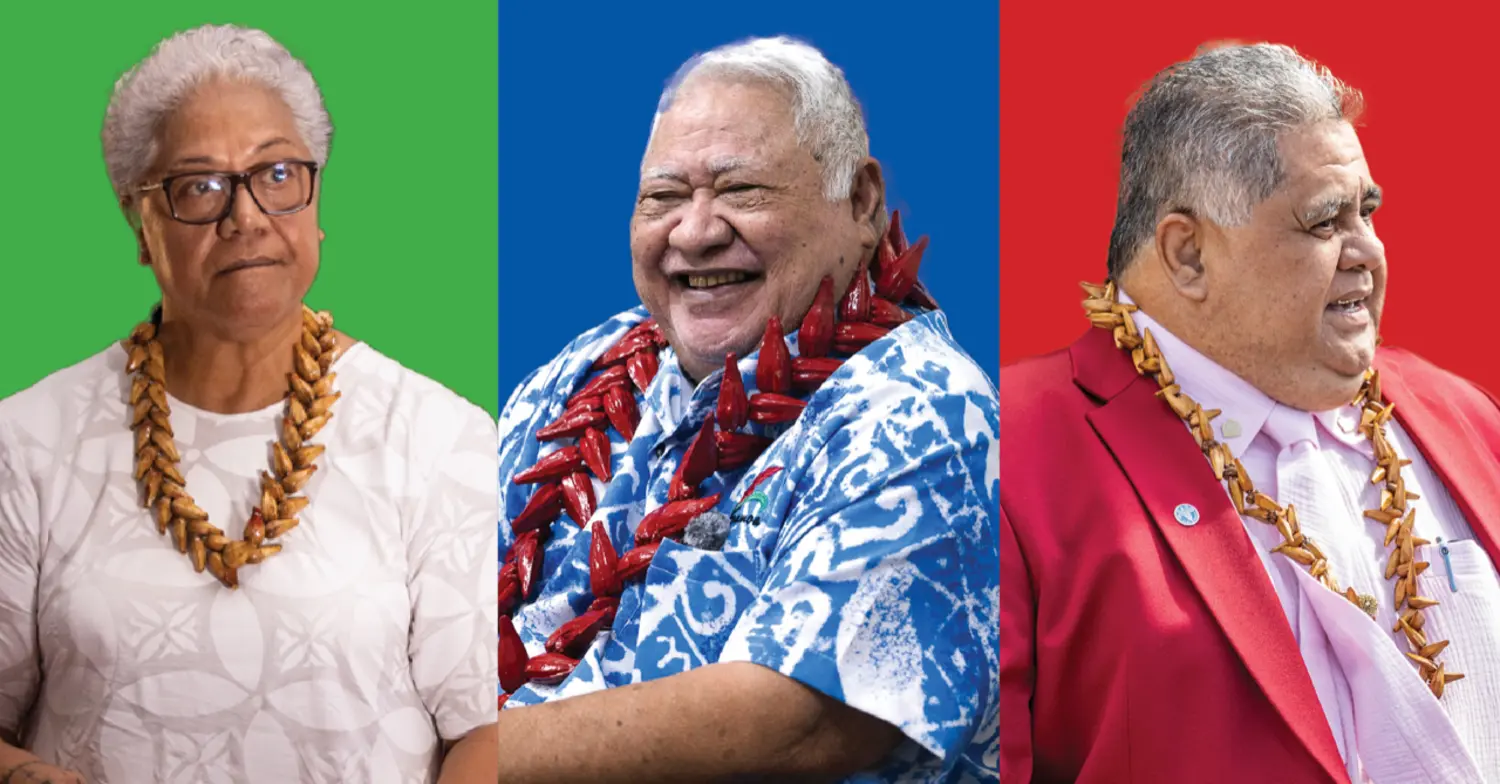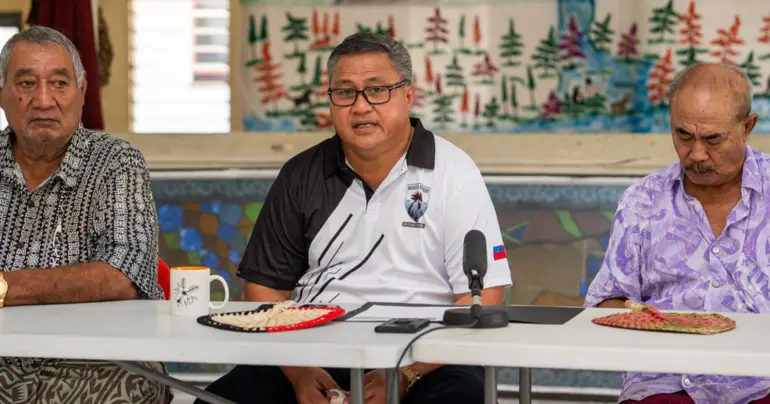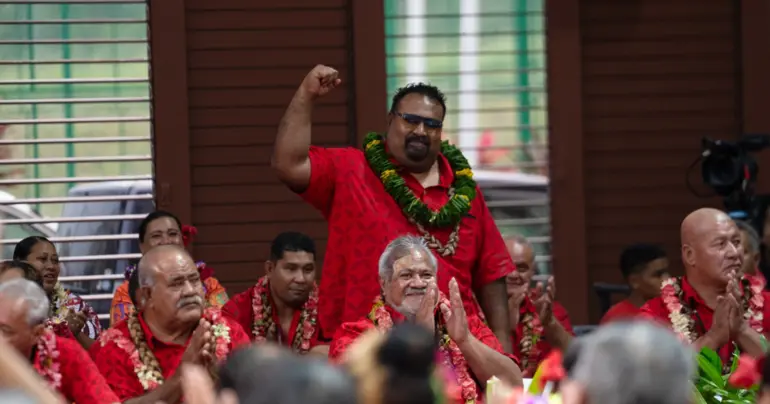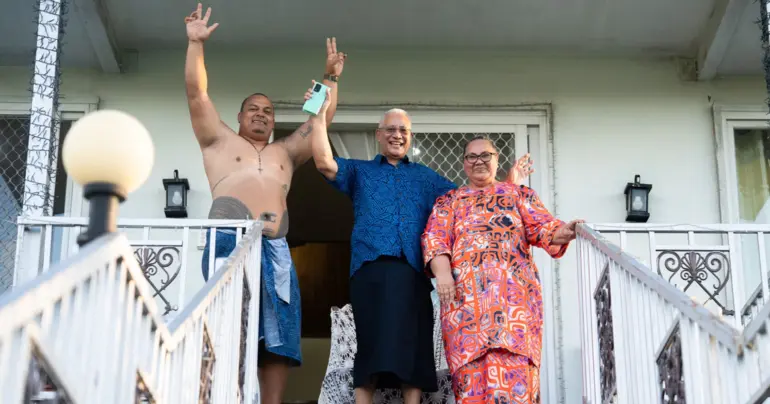What the three major parties are promising Samoa
 By Sulamanaia Manaui Faulalo
•
28 August 2025, 1:20PM
By Sulamanaia Manaui Faulalo
•
28 August 2025, 1:20PM
With the polling day on Friday, here’s a look at the headline promises from the three main parties — Human Rights Protection Party (HRPP), Fa’atuatua i le Atua Samoa ua Tasi (FAST), and Samoa Uniting Party (SUP).
Samoa’s three major political parties — Fa’atuatua i le Atua Samoa ua Tasi (FAST), the Human Rights Protection Party (HRPP), and the Samoa Uniting Party (SUP) — released manifestos promising sweeping reforms in health, education, the economy, and governance ahead of the general election.
All three parties promise to ease the cost of living and boost development, but their approaches differ.
FAST, which swept into power in 2021, highlights family welfare as its core priority. Its manifesto proposes free medical visits and medication for pregnant women, children, the elderly, and people with disabilities, along with higher pensions and disability allowances. It also promises free schooling, school lunches, and new hospitals, including one in Salelologa. FAST emphasises raising the minimum wage to $6 per hour, tax relief for low-income earners, and major investments in infrastructure — from ferries and airlines to renewable energy and hotel redevelopment. The party also pledges to expand overseas consulates, negotiate better visas, and allow Samoans abroad to vote.
HRPP, which ruled for nearly four decades before losing power, focuses heavily on easing inflation and social assistance. Its plan allocates $110 million for cost-of-living relief, including $500 annual cash payments, tiered pensions rising to $500 a month for those 85 and older, and $1,000 payments for newborns. HRPP also proposes reducing taxes from 27 to 25 per cent, removing GST from basic foods, and paying tuition costs up to university. It outlines infrastructure projects such as the Tiavea airport, Vaiusu wharf, Fagaloa tunnel and a bridge linking Upolu and Savai’i, while pledging free internet for schools and telehealth services for rural communities.
SUP presents a faith- and culture-centred platform, prioritising partnerships with churches and preserving Samoan values. It pledges free education from early childhood to university, higher teacher grants, and 300 doctors nationwide. SUP also promises to drop VAGST to 12 per cent, eliminate it on frozen foods and renewable energy, and increase pensions to $500 a month with retirement at 60. The party sets aside $50 million annually to support businesses, aims to boost exports and tourism, and promises to build an international port in Asau and new roads.
While all three parties share commitments to health, education, and infrastructure, their emphases differ: FAST leans toward social protection and diaspora engagement, HRPP toward inflation relief and large-scale infrastructure, and SUP toward cultural preservation and easing the cost of living through tax cuts.
Samoa Uniting Party (SUP)
SUP’s manifesto is rooted in cultural revival, good governance, and social cohesion. It blends traditional Samoan values with modern development priorities. The promises are designed to resonate with families, churches, and districts, while also appealing to the working class and pensioners. The overall message is one of unity and cultural preservation, with a strong emphasis on social programmes.
Fa'atuatua le Atua Samoa ua Tasi (FAST)
FAST frames itself as progressive and institution-focused, drawing on its position as the governing party. Its manifesto highlights major investments in infrastructure, renewable energy, and social programmes. The policies are pitched toward youth, workers, families, and Samoans living abroad. The vision combines social protection with long-term development, aiming to balance welfare support with nation-building.
Human Rights Protection Party (HRPP)
HRPP’s manifesto is strongly welfare-driven, built around direct cash benefits such as COLA, PELEGA, and SUPA, alongside permanent subsidies. It focuses on financial assistance and broad-based state support for families, pensioners, and the vulnerable. This reflects the party’s long history in government and appeals to those seeking immediate, tangible relief.
SUP:
• Districts: $1.8 million per constituency (51 constituencies)
• Businesses: $50 million every year to support local businesses.
• Education: Increase school grant from $18 million to $30 million to cover teachers and school support.
• Private Organisations: $3 million allocation. • Housing: $1 million to assist with housing.
• Key theme: SUP focuses on district funding, small business support, and education grants. Compared to FAST and HRPP, the promises are smaller in scale, but still significant in recurring costs.
FAST
• District Development: Continue the $1 million per constituency grants (51 constituencies), with proposals to increase to $2 million.
• Air Transport: $300 million to purchase a new plane for Samoa Airways.
• Sea Transport: $50 million for new ferries, including routes to Savai’i and American Samoa.
• Tourism: $100 million for hotel redevelopment and upgrading.
• Energy: Several $50 million packages for renewable energy, EPC, and solar expansion.
• Water & Utilities: $50 million support for the Samoa Water Authority.
• Sports: $30 million to upgrade sports facilities.
• Other initiatives: Multiple $50m lines for horticulture, importing goods, and Development Bank support.
• Key theme: FAST is promising large capital investments in transport, tourism, energy, and infrastructure — big one-off projects that would require major borrowing or outside funding.
HRPP:
• Cost of Living: The COLA program is worth about $110 million, giving $500 a year to every Samoan.
• Elderly Support: Pelega pensions for the elderly, around $68 million a year.
• Disability Support: Supa program, $32 million to assist people with disabilities.
• Education: Pay for teachers and cover tuition fees, estimated at $60 million.
• Youth & Entrepreneurs: $20 million for entrepreneurs, plus $10 million for youth programs.
• Note: COLA, PELEGA and SUPA are promised to take effect in the first 100 days if the HRPP are successful.
• Key theme: HRPP’s promises are focused on direct financial support for families, the elderly, the disabled, students, and small businesses — mostly recurring payments that would be permanent annual costs.
What the budget means for Samoa's 2025/2026 $1.2B Budget
Samoa’s proposed 2025/26 budget of $1.2 billion failed to pass, triggering tomorrow’s snap election. If we compare each party’s major promises with that figure, here’s what it could look like:
Health:
SUP: Free checks for mothers, pensioners, and children under 2; upgrade hospitals; recruit 300 doctors.
FAST: Insurance for all, new Salelologa hospital, and free visits for schoolchildren, pensioners, and the disabled.
HRPP: Improve Motootua and district hospitals, roll out telehealth, mobile clinics, and pay for treatment overseas.
Budget lens: Health spending already sits near SAT 160m. HRPP and FAST pledge sweeping systems that could double this figure. SUP’s proposals are narrower but still resource-heavy.
Education:
SUP: Free education from preschool to university; raise grants from $18m to $30m.
FAST: Free schooling to college, free lunches, teacher pay for church schools, and $50m+ in facilities.
HRPP: $60m for teachers and tuition; scholarships tied to business partnerships.
Budget lens: Current education budget is SAT 120m. SUP’s free university policy could easily overshoot this. FAST’s school lunches and upgrades would add tens of millions. HRPP’s $60m sits closer to reality but still stretches public finances.
Social Welfare & Poverty Alleviation
SUP: $500 monthly pension, $200 per immunised child, $200 per month disability allowance, $1m for housing.
FAST: $100/month for children under 3, disability allowance lifted to $300, pensions at $300–500 fortnightly.
HRPP: COLA ($500 annually for all adults), PELEGA pensions scaling up to $500/month, $300/month for disabled, $1,000 newborn bonuses.
Budget lens: Welfare already costs SAT 140m. HRPP’s COLA/PELEGA/SUPA package alone tops SAT 210m. SUP’s pension hike is even heavier. FAST’s child and pension schemes fall between, but still push costs to unsustainable levels.
Taxes:
SUP: Drop VAGST to 12%, no VAGST on frozen foods or renewables, 20% tax return.
FAST: No tax for those earning ≤$20k, cut business tax to 23%, remove GST
HRPP: Reduce income tax from 27% to 25%, remove GST on basic food items
Budget lens: VAGST contributes nearly 40% of Samoa’s revenue. SUP’s 12% proposal could slash SAT 100m+ in revenue; however, the other two parties' removal of tax altogether and no position on how to counter the missing numbers could mean a bigger hole to fill.
SUP (Samoa Uniting Party / Samoa Ua Potopoto)
• International port at Asau — A major investment aimed at opening up Savai’i to international trade and tourism.
• Renew ferries for Savai’i — Essential but costly given Samoa’s ageing fleet.
• New plane for Samoa Airways — SUP promises to partner with the airline to bring in new capacity.
• 5,000 acres of government land released for lease — One of the largest land release programmes proposed in years.
HRPP (Human Rights Protection Party)
• Fagaloa Tunnel — A massive project to connect the east coast with the capital, easily in the hundreds of millions.
• Tiavea International Airport — Reviving a stalled project; building an entirely new airport would be a billion-tala undertaking over time.
• Bridge between Upolu and Savai’i (Alalaupapa Bridge) — Promised by 2035, this would be the most ambitious transport link in Samoa’s history.
• New planes for Samoa Airways — Expanding the fleet to secure regional routes.
FAST (Fa’atuatua i le Atua Samoa ua Tasi)
• $300 million plane for Samoa Airways — The single largest price tag in any manifesto.
• $100 million hotel redevelopment fund — Targeted at reviving struggling tourism businesses.
• $50 million for new ferries — To connect Savai’i and American Samoa.
• $50 million each to EPC and SWA — Direct injections into power and water infrastructure.
• $1.5 billion from carbon credits — A highly ambitious revenue plan, dependent on international markets.
 By Sulamanaia Manaui Faulalo
•
28 August 2025, 1:20PM
By Sulamanaia Manaui Faulalo
•
28 August 2025, 1:20PM











